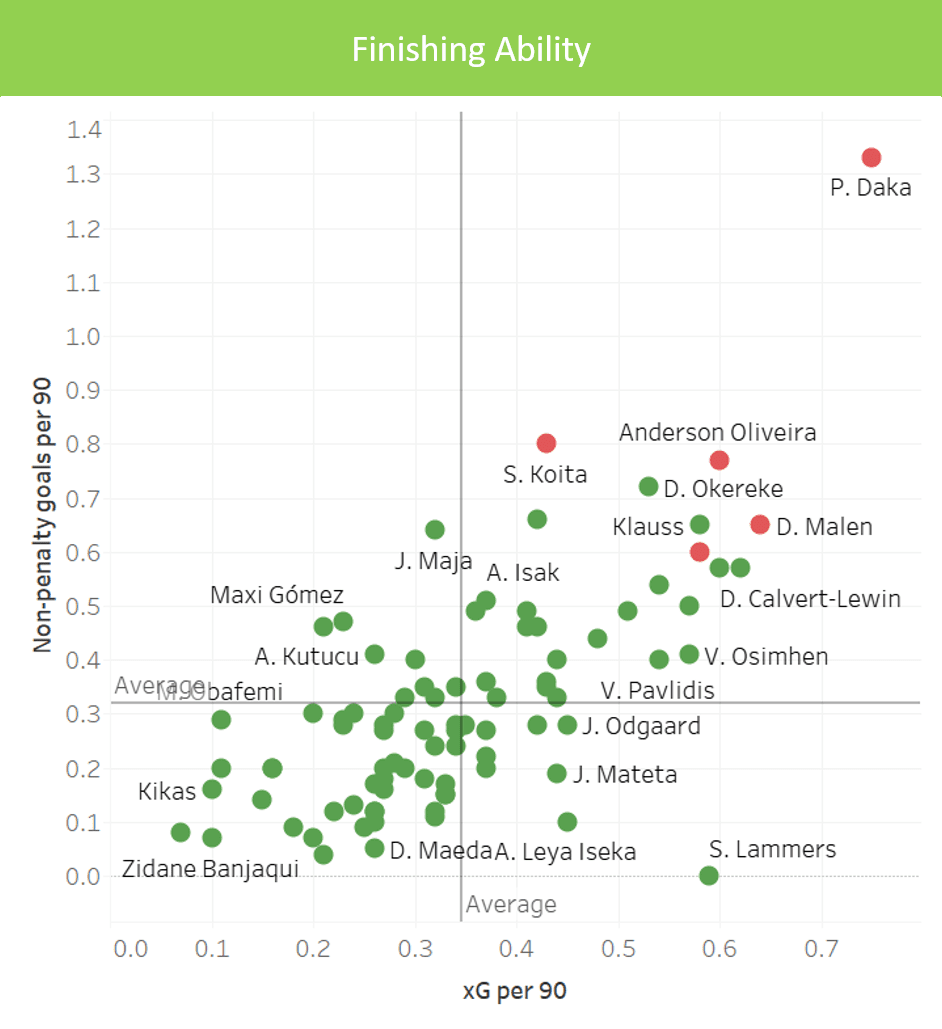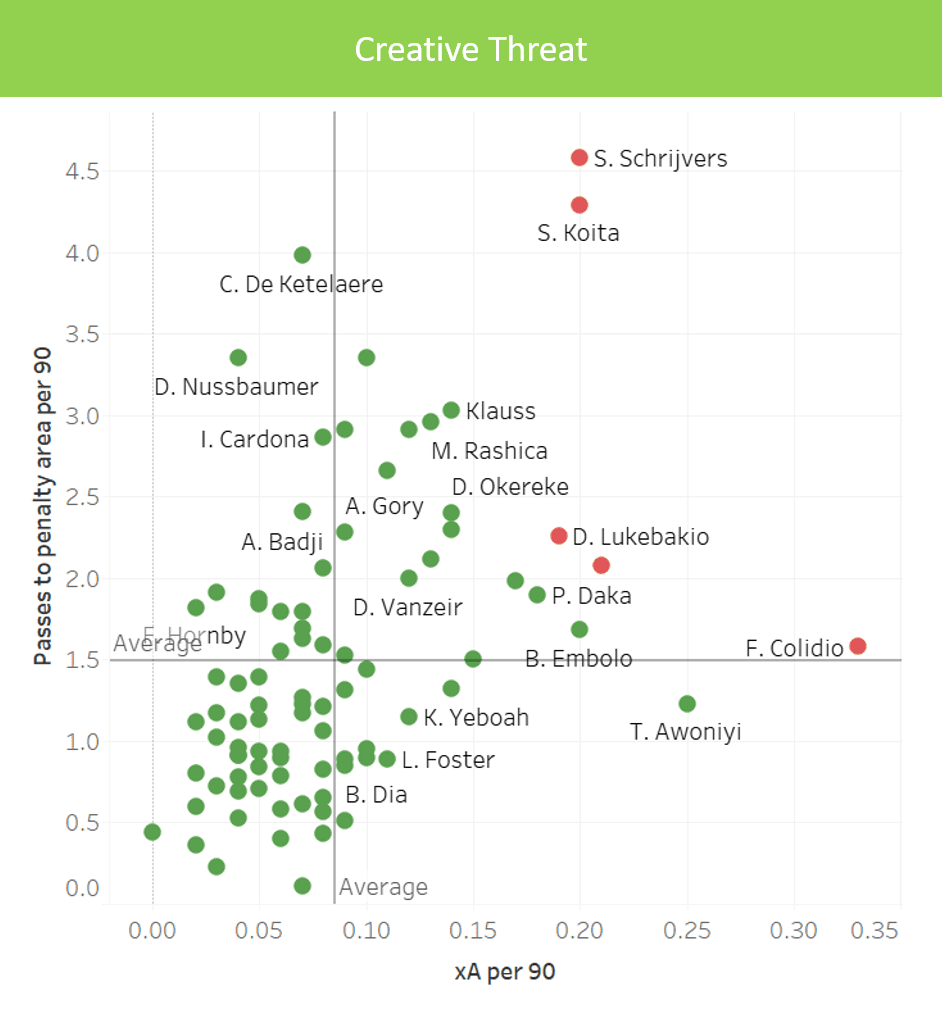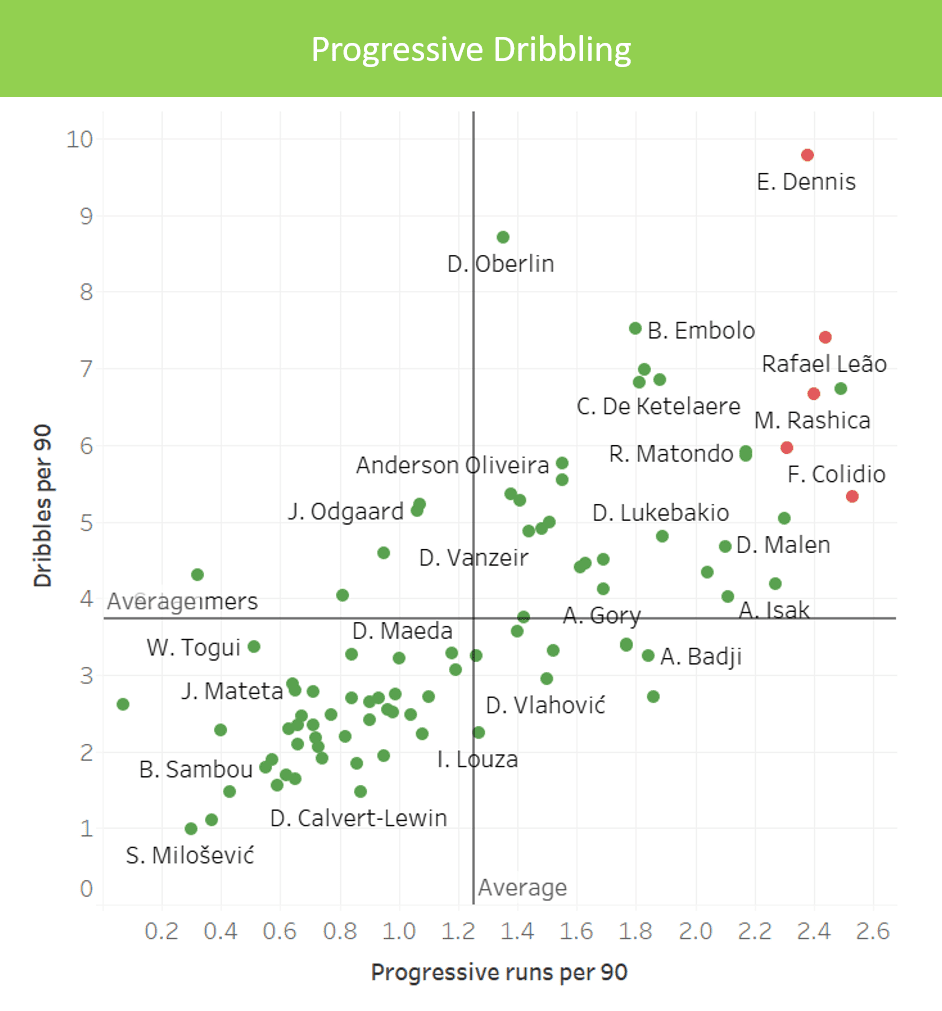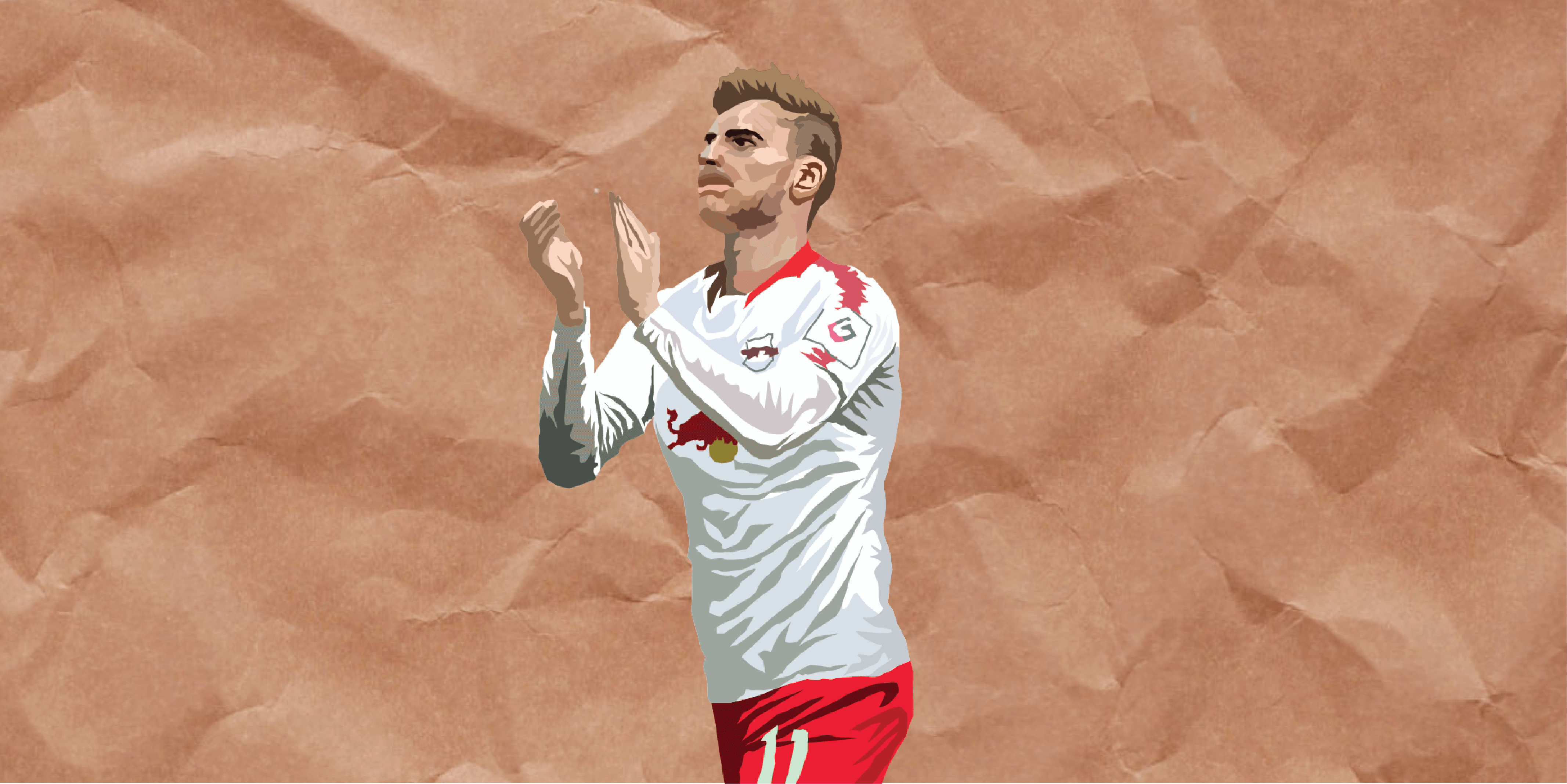The sale of Timo Werner came as a surprise to the world of football, not for the fact he was sold, but at the destination he chose for the next step in his career. Many expected the German to move to Liverpool instead of Chelsea. Nonetheless, this does not change the reality that RB Leipzig have to replace the elite striker this summer if they are not to put their trust in one of their current forwards, such as Ademola Lookman or Patrik Schick (on loan) to replace him.
Werner at 20-years of age played 2,435 minutes of football for Leipzig in the 2016/17 season, scoring 21 goals and creating five assists, as Die Roten Bullen romped to 2nd place in their first season of Bundesliga football. Three years later, Julian Nagelsmann arrived at Leipzig and does what he does best, which is supercharging the attack. Werner certainly benefitted from his arrival, improving in almost every offensive aspect.
To replace Werner, we must begin to understand where the German excels. Of course, he is an excellent goal scorer, exceptionally capable at finding space inside the box to take a shot on goal, he is also remarkably creative for a centre-forward, and he is talented at taking on his man as well. Essentially, Werner is a complete-forward, with the only thing he lacks is the aerial ability, which is covered by Youssef Poulsen in the Leipzig attack anyways.
This data analysis will help us to highlight, through the use of data and statistics, the greatest replacement for Werner at RB Leipzig. Our dataset consists of players who have a good proportion of minutes as a centre-forward, aged 23 or under, are valued at £50m or under (the price Werner was sold for) and have accumulated at least 500 minutes in the league (in Europe’s top five leagues, plus Liga NOS, Jupiler Pro League, Eredivisie, and Austrian Bundesliga).
This data analysis can be used to help identify players who are competent enough to deliver output instantly, while also garnering potential to grow into an elite forward in the future, to replace Werner at Leipzig. At the end of the analysis, we will highlight the five players who could have a similar impact to Werner after exploring statistics concerning multiple key outputs which we have identified to be Werner’s best characteristics.
Finishing ability
The main and most obvious feature of Werner’s game is his finishing ability. More importantly, across his last two seasons at Leipzig, he has managed to overperform his xG per 90, proving how clinical he truly is.
The first section of this data analysis displays our sample across two metrics which assess their capability to finish the chances they have either created for themselves or has been created by others.
Non-penalty goals per 90 (npG per 90) are key in understanding how good a striker is within open-play, as not every striker takes penalties for their respective clubs, whilst xG per 90 demonstrates the quality of chances they are finding themselves getting into per game.

Zambian Patson Daka is the clear outlier in both metrics here, indicative of his outstanding season. His 1.33 npG per 90 stands as a ridiculous figure, and quite a distance better than second place. His xG per 90 of 0.75 stands as the best within our dataset as well.
Ranking second place for npG per 90 with 0.8 is RB Salzburg’s Sékou Koïta. After enjoying a very successful loan spell with Wolfsberger AC in 2018/19, it was only a matter a time before he was given a chance in Salzburg’s starting XI. Although he has played just 671 minutes of league football this campaign, he has generated an above-average 0.43 xG per 90.
A player who ranks especially high in both metrics is Anderson Oliveira. The 22-year-old Brazilian has 0.77 npG and 0.6 xG per 90. He has racked up only 695 minutes of league football for Famalicão this term, but generally whenever called upon he has come up with the goods.
A player who received much media praise at the start of this season is PSV Eindhoven’s, Donyell Malen. He was the recipient of the majority of his praise after a single game where he smashed home five goals in one match. He has an impressive 0.65 npG per 90, with an equally impressive xG per 90 of 0.64, suggesting he is on par with his finishing.
Finally, another Dutchman who has been flying this season is 19-year-old Myron Boadu. He is another player who is finishing on par with the chances he is getting himself into, combining 0.6 npG per 90 with 0.58 xG per 90.
Passing threat in the final third
Werner is a forward who is a threat in the final third owing to passing as well as his finishing. Although his primary tool in the final third is his finishing, he is also tremendously creative as well, capable of putting up good assist numbers every season. The interplay he has with his teammates is part of what makes him so suitable to Leipzig’s style of play.
The following offensive metrics look to qualify our samples ability through an analysis of passes to penalty area per 90 and xA per 90. This section will help us to identify individuals who are active in the final third, with the ability to accurately find their man in the penalty area, and who are capable of creating high-value chances with those passes.

The player who leads the way for xA per 90 is Facundo Colidio of Sint-Truiden (On loan from Inter), at 0.33. It is intriguing to see that he has an average value of 1.58 passes to penalty area per 90, so it is evident that he is very efficient with his choice of passing in the final third.
Alternatively, the player who leads the way for passes to penalty area is Siebe Schrijvers, with 4.58 per 90. Playing for Jupiler Pro League’s dominant force Club Brugge, he has seen a lot of the ball whenever on the pitch, though it is worth noting he has played a decent number of minutes out on both wings as well. He produces a good xA per 90 value of 0.2 additionally.
The only recurring name from the analysis of clinical centre-forwards is Sékou Koïta. In addition to his impressive finishing ability, he is also great in both passing metrics, with 4.29 passes to penalty area and 0.2 xA per 90.
Next up we have Dodi Lukebakio. The Hertha BSC player has been averaging 2.26 passes to penalty area per 90 combined with an xA per 90 of 0.19. His xA value is the more impressive of the two metrics here, which has been partially helped by his game time out on the wings.
Lastly, Colombian international Luis Sinisterra ranks highly in both of these metrics. He completes 2.08 passes to penalty area per 90 and that has helped him achieved 0.21 xA per 90 as well. In combination with a very strong defensive contribution, Sinisterra makes for an incredibly unique and talented prospect.
Progressive dribbling
We have now analysed some finishing and passing data. Before we shortlist five U23 strikers and analyse them in detail, we are going to reveal which centre-forwards are effective with the dribbles they attempt. By looking at dribbles and progressive runs per 90, we can gather an understanding of which players are effective in their dribbling contribution.

Emmanuel Dennis is the clear outlier concerning dribbles per 90, standing at 9.78. While he has the highest volume of dribbles per game, his success rate is sub-par, at 45%. Although Club Brugge came 3rd in their Champions League group, he had some great displays in that period, which exhibits his strong current ability at such a young age. His 2.38 progressive runs per 90 indicate that he is providing a great value in terms of ball progression with his dribbles.
In Italy, playing for AC Milan, Rafael Leão has produced good dribbling numbers this season, despite his limited attacking output. The 20-year-old has been averaging 7.4 dribbles per 90 at an above standard success rate of 57.45%. With 2.44 progressive runs per 90, we can see that he is more efficient than a typical young forward with his dribble attempts.
Kosovan Milot Rashica deserves a mention, the Werder Bremen forward ranks highly for both metrics this season. The volume of his progressive runs per 90 at 2.4 is where he particularly excels, which is a result of his 6.66 dribbles per 90 at a 52.66% success rate.
Facundo Colidio came up when we discussed passing threat and again, he has some impressive statistics. His 5.97 dribbles per 90 is an impressive figure combined with a 51.02% success rate which is solid for a young forward. His 2.31 progressive runs per 90 is also a great figure, which demonstrates how much of a well-rounded forward he is.
It is also worth bringing attention to Federico Chiesa who has occupied a type of ‘false-nine’ role for Fiorentina this term. He leads the way for progressive runs per 90 with 2.53, which is impressive considering the lower proportion of dribbles he attempts, at 5.32 per 90, with a noteworthy 59.02% success rate.
Shortlist
After examining every individual across the sample concerning their individual performances across each data metric, I have managed to narrow it down to the following six individuals. The darker the green, the higher the score.

Alexander Isak, CF, 20 years old, Real Sociedad

It is worth noting that although Isak has not been mentioned in the earlier analysis, he does rank highly for a player within one of Europe’s top five leagues, where the quality of opposition is higher. Besides, he is extremely young, at just 20-years-old, which makes his statistics even more impressive. This season, he outperformed his 0.37 xG per 90 by scoring 0.51 npG per 90, which is indicative of his impressive finishing akin to Werner. He ranks especially high for progressive runs (9th in the dataset) with 2.27 per 90, which demonstrates his strong ability to progress the ball at his feet. His market value is £22m.
Breel Embolo, CF, 23 years old, Borussia Mönchengladbach

Breel Embolo made the smart decision to move from Schalke 04 to Borussia Mönchengladbach last summer to get more game time under his belt. His 0.48 xG per 90 is a very impressive figure and it will be interesting to see if he is trusted with a starting birth more regularly next season and whether that statistics will rise or fall. He ranks 4th in the dataset for xA per 90 with 0.2, as well as his 7.52 dribbles per 90 at an average 47.93% success rate, which all displays his versatile contribution as a blossoming young forward. His market value is £13m.
Donyell Malen, CF, 21 years old, PSV Eindhoven

The Dutchman is one of the most coveted young forwards in Europe based off this season’s performance, and rightly so. Despite his season ending early due to a knee injury, he put up some phenomenal numbers this season for PSV. His 0.64 xG per 90 ranks 2nd in our dataset, and is a brilliant figure for any striker, regardless of their age, and combined with his 0.65 npG per 90, he will generally finish the chances he is expected to. His 0.14 xA and 2.3 progressive runs per 90 both rank very highly (11th and 8th respectively) which demonstrates how well-rounded he has been this term, just like Werner. His market value is £25m.
Myron Boadu, CF, 19 years old, AZ Alkmaar

The 19-year-old AZ youth prospect is the youngest player in this shortlist and as a result, he is the least developed of the bunch. His 0.58 xG and 0.6 npG per 90 rank as 7th and 9th respectively in our dataset, which is mightily impressive for a player in his debut campaign as a starting figure in competitive football. Besides his 0.1 xA per 90, his other statistics do not stick out as particularly remarkable, but as a very young player, he has time on his side to improve on these aspects of his game. His market value is £18m.
Patson Daka, CF, 21 years old, RB Salzburg

Daka is truly the best by a sizeable distance in terms of his finishing ability out of our dataset. Of course, he ranks first for his 1.33 npG and 0.75 xG per 90, which beats his former teammate Erling Braut Håland in both regards this season as well, given it is in a much weaker league. His creative numbers are impressive as well, although his dribbling ability could be improved upon. Nonetheless, his positives far outweigh his negatives, and it will be intriguing to see if this is just a freak season or not, given his weaker performances in European competitions this term. His market value is £7m.
Sékou Koïta, CF, 20 years old, RB Salzburg

Another centre-forward playing for RB Salzburg, Koïta has been magnificent to watch when he has featured this campaign. He has been exceptionally clinical, scoring 0.8 npG per 90 from 0.43 xG per 90, even if that is an overperformance he will not be able to maintain, his xG per 90 is still a very healthy value. Also, he ranks 4th for his 0.2 xA per 90 and 2nd for his 4.29 passes to penalty area per 90, so he is a creative threat in the final third as well. His dribble success rate of 20.51% is less than extraordinary, but Werner was once in a similar boat, and he improved decidedly in this regard. His market value is £4m.
Summary
Now we have a shortlist of players who would be a suitable replacement for Timo Werner, especially in the long-term. Ranging from 19 to 23 years old, this shortlist features six players with analogous current ability, a versatile range of attacking contribution, and all of them possess most of the key feature’s that are dominant in Werner’s game. These individuals are capable of providing a respectable amount of output straight away whilst having plenty of room for growth.
We have seen Nagelsmann extract top-level attacking output out of less technically-able players in the past (e.g. Ishak Belfodil), so to suggest that these players are talented enough to deliver an immediate impact just like Werner did back in 2016 is not a naïve statement. While it is always a risk to buy outside of Europe’s top five leagues, we have specifically chosen players who would fit into Leipzig’s system seamlessly, thanks to their style of play. Even if you may have to pay above their market value, each of these players also represents a good value in the current market, with the potential to sell-on for a serious profit in the future.





Comments